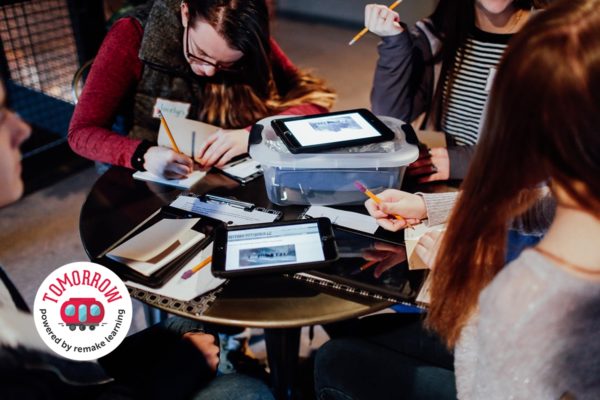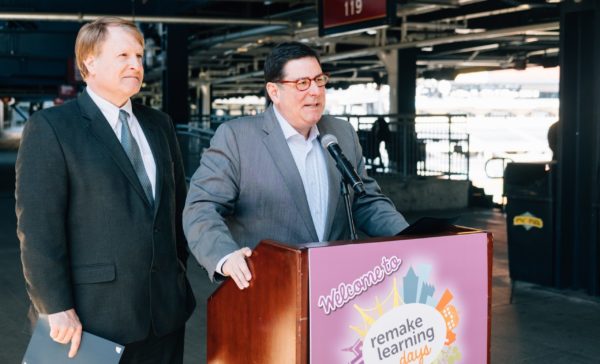
Math quiz: Could grassroots innovation + pandemic-fueled change = true transformation?
By Melissa Rayworth
When Lena Hannah discovered the innovative mental health program happening at Bentworth School District, she knew it had to be shared. Bentworth, busy serving a cluster of small communities in the far southwestern corner of Pennsylvania, was quietly doing something remarkable.
By partnering with a network of clinics in their area, Bentworth was offering mental health services from trained counselors inside their school buildings. Students got crucial support without being pulled away from the familiar structure of school and friends.
Hannah saw a growing community of students thriving because of this innovation. But how many more kids across Pennsylvania — and across the country — could be helped if the program were scaled up and replicated elsewhere? Through her job as a PSBA advocacy ambassador for school districts in the Pittsburgh region, she reached out to state senator Camera Bartolotta, who invited Pennsylvania’s secretary of education and secretary of human services to visit Bentworth in 2018.
If legislators can see firsthand what’s going on in the schools they represent, they can use that knowledge and share it with other lawmakers to get valuable programs funded, Hannah says. That’s one powerful method for scaling up grassroots innovation into widespread public policy.
Even before COVID-19 disrupted schooling last spring, we’d been living in a time of powerful education innovation. In recent years, communities have begun building learning ecosystems. We’ve seen school districts embracing new methods of assessment, thoughtfully infusing technology into daily learning and prioritizing social-emotional skills.
That spirit of grassroots innovation is now colliding in a potentially remarkable way with the sudden changes necessitated by the pandemic.
There are moments in history when the world is especially open to learning new ways of doing things, says Linda Darling-Hammond, president and CEO of the Learning Policy Institute. Right now, we’re living in one of those historic moments for learning, she says, and we can consciously build a better future for all learners if we seize the opportunity.
Small innovations can be scaled up, so that public policy can transform learning opportunities for all teachers and students.
Where do we begin? We do what Lena Hannah did when she discovered that mental health innovation at Bentworth: Spread the word about what’s working.
“Obviously, raise the concerns about where there are problems. But where you see things that are working, go tell your principal: ‘Hey, this teacher did this thing was really great. You should have her teach the other teachers how to do that,'” says Darling-Hammond.
“What we need to be explicitly encouraging is how the amazing creativity of human beings can be shared across classrooms, across schools, across districts, across states,” she says, “so that at the end of this we have had a leap forward in the way that we educate kids.”
This kind of scaled-up innovation doesn’t have to happen state-wise all at once.
“Policy happens at the local level, as well as the state and federal level,” says Darling-Hammond. “So parents and educators can be working at the local level to say, ‘We don’t want to go back to school as usual. We want to take advantage of innovations that are occurring here.'”

Hannah agrees: If you see one teacher doing something innovative and valuable, send an email to your superintendent and school board members to explain what you’ve seen. Teachers and program directors doing remarkable work are often so busy making good things happen that they don’t have time to publicize their work.
They’re often quite humble, too, Hannah says, so their first instinct may not be to suggest their work be scaled up district-wide.
One way communities can foster this is by creating a clear method for parents and caregivers to communicate. South Fayette School District in the Pittsburgh area has created a dedicated email address that reaches the superintendent and board members. The superintendent responds to the individual messages that come in, but all the recipients take note of the ideas and concerns shared by community members.
Parents and caregivers are more involved in learning than ever, as recent data from the Brookings Institution has illustrated. They are collaborating with schools and understanding the challenges teachers face, and they’re appreciating the creative approaches teachers are finding to make sure students thrive during this difficult year.
So parents should draw attention to these creative approaches and encourage districts to share them more widely.
For example, Darling-Hammond says, parents can say, “We had this great experience with this special ed paraprofessional who was able to help us learn how to work with our son in a new way. You should figure out how to scale that up.”
Parents, she says, “should be a voice for scaling these things up and pointing them out to school and district leadership.”
And in an effort to build real-world applications of learning, businesses and nonprofits can approach their local superintendents and school boards to get involved.
The recent Restarting and Reinventing School: Learning in the Time of COVID and Beyond report from the Learning Policy Institute prioritized helping students connect their lessons to real-world applications. Schools can help learners stay engaged, the report says, by “allowing students to explore the world around them and to demonstrate what they know through projects and presentations that display the products of their work.”
Hannah says businesses can offer to bring students in for internships and hands-on learning experiences to foster this kind of learning. Once a program like that is underway, it can be shared with neighboring districts.
Communities can also partner together to pursue funding, effectively scaling up good ideas in small groups.
South Fayette School District collaborated with seven additional districts — four in rural areas and three in urban communities — to earn a $500,000 PAsmart Grant for building and sharing a curriculum that teaches computational thinking to K-8 students. The grant includes funding for teacher professional development: More than 400 teachers across the state have now been taught this curriculum, so they can bring it home to their districts.
Remarkable things like this are happening everywhere, and communities can use this malleable moment to build on them.
“I don’t think there’s any way we can go back to business as usual. Now, whether we keep the best things and build on them is the decision we have to make,” Darling-Hammond says. “Will we keep the best of it in a deliberate way, so that it’s more than an exception to the rule? That’s really the question.”
This article is part of a series for “Tomorrow” powered by Remake Learning. From May to October, “Tomorrow” will explore – through virtual events, grantmaking, and storytelling – what we can do today to make tomorrow a more promising place for all learners. Follow along or share your hopes for today’s young people using the hashtag #RemakeTomorrow and tagging @RemakeLearning. Learn more about Remake Learning here. And read more “Tomorrow” articles published on Kidsburgh.